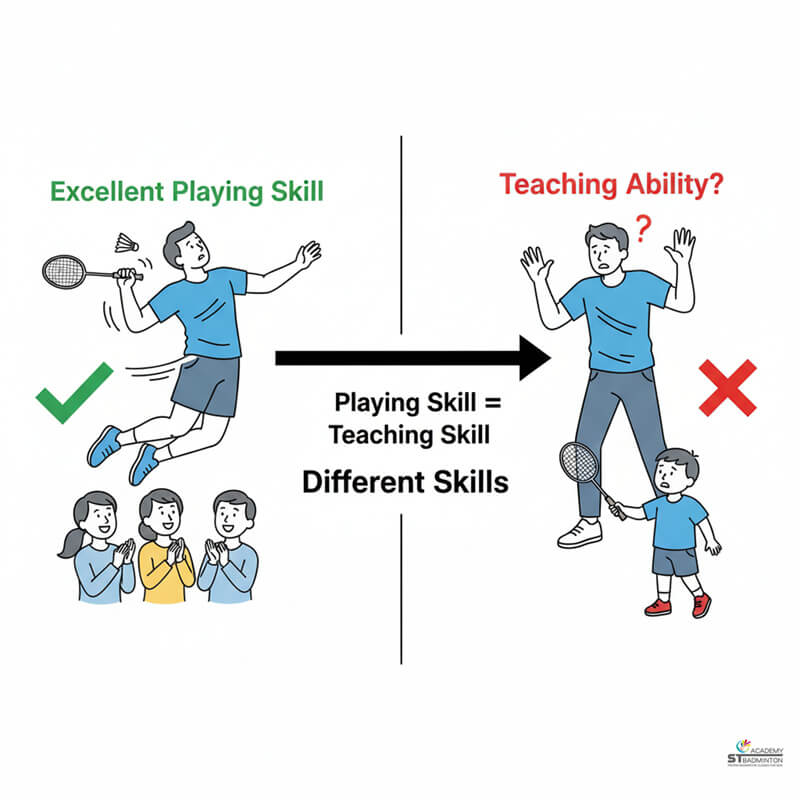How Can You Incorporate Plyometrics Into Your Badminton Training? (Malaysia & Singapore)
As a coach in Malaysia and Singapore, I see many players try “jump training” without structure and end up with knee pain instead of real power. With the right plyometric progressions, we can train explosive movement in a way that supports your badminton, instead of damaging your joints. This guide helps serious juniors, school team players and adults in Setapak, Wangsa Maju, Kepong, Cheras and surrounding areas understand how to incorporate plyometrics safely into weekly badminton training.
A certified badminton coach explains what plyometric training is, why it improves jump height and acceleration, which exercises suit badminton players, and how to progress without overloading joints.

Plyometric Benefit #1
Improved Vertical Jump Height for Stronger Badminton Smashes
Plyometric training for badminton helps players develop higher jump smashes by strengthening the explosive power of leg muscles through repeated jumping and landing exercises. Research shows that structured plyometric programs lasting six to eight weeks can significantly increase vertical jump height in badminton athletes, allowing them to contact the shuttle at a higher point and generate more downward power during attacking shots.
Players from Setapak, Wangsa Maju and Cheras who incorporate controlled plyometric exercises like squat jumps and counter-movement jumps into their weekly training see noticeable improvements in their ability to jump quickly and land safely. Our certified coach at ST Badminton Academy teaches proper landing technique and progression before adding intensity, ensuring that increased jump height comes from trained muscle power rather than reckless effort that risks knee or ankle injury.
School team players across Kuala Lumpur and Singapore who combine plyometric work with regular badminton footwork and technique drills develop more complete explosive capability that transfers directly to match performance in jump smash situations.

Plyometric Benefit #2
Faster First Step and Change of Direction for Better Court Coverage
Plyometric exercises for badminton players improve acceleration and change of direction speed by training the stretch-shortening cycle in muscles, allowing faster push-off from lunges and quicker responses to opponent shots. Lateral bounds, split squat jumps and multi-directional hops strengthen the specific movement patterns needed for explosive side-to-side and front-back coverage across the badminton court in Malaysia and Singapore matches.
Working adults from Selayang, Kepong and Ampang who add targeted plyometric drills to their training schedule notice improved reaction time and reduced delay between reading the shuttle and starting movement. Our coaching team at ST Badminton Academy emphasises quality over quantity in jump training, teaching players to maintain proper knee alignment and hip stability during rapid direction changes to protect joints while building explosive power.
Research combining balance training with plyometric work shows even greater improvements in change-of-direction performance and lower limb injury prevention for badminton athletes, making the combination particularly valuable for school team players preparing for tournaments across Kuala Lumpur and Singapore.
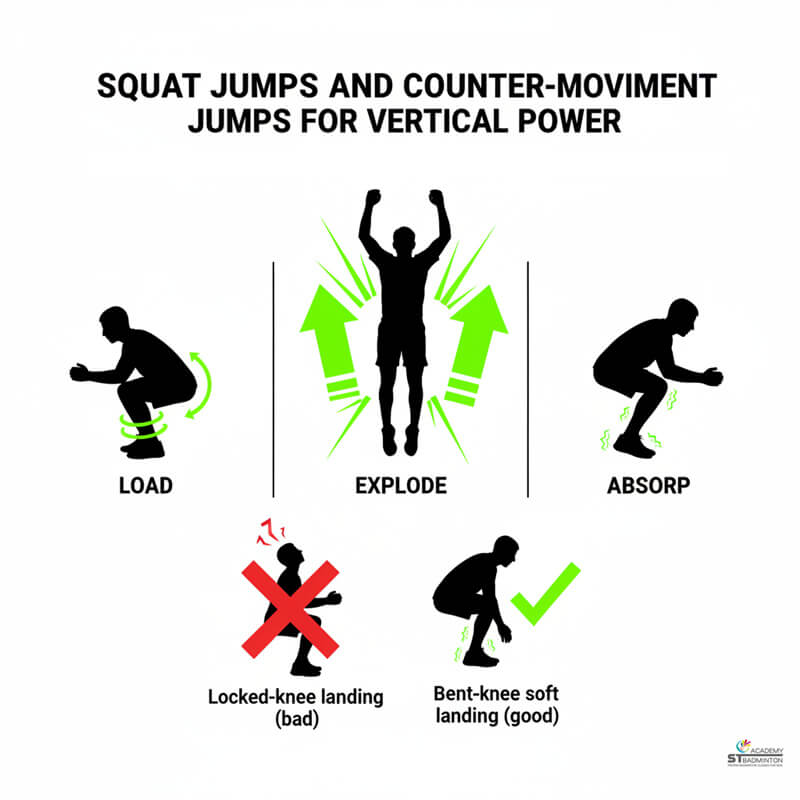
Core Exercise #1
Squat Jumps and Counter-Movement Jumps for Vertical Power
Squat jumps are fundamental plyometric exercises where players lower into a squat position then explosively jump upward, focusing on maximum height and controlled soft landing on the balls of the feet with bent knees. Counter-movement jumps add a quick dip before the jump to engage the stretch-shortening cycle more effectively, training the rapid muscle response needed for badminton jump smashes in Kuala Lumpur and Singapore matches.
Players from Sentul, Gombak and Cheras should start with basic bodyweight squat jumps, performing two to three sets of five to eight repetitions with full recovery between sets to maintain quality. The key technical points are landing softly without knee collapse, keeping the chest stable and core engaged, and avoiding excessive forward lean during takeoff or landing. Our certified coach at ST Badminton Academy teaches these foundational movements before progressing to more complex plyometric variations.
Common mistakes include landing with locked knees, allowing knees to cave inward, or rushing repetitions without proper form, all of which increase injury risk and reduce training effectiveness for badminton-specific explosive power development.

Core Exercise #2
Split Squat Jumps and Lunge Jumps for Single-Leg Strength
Split squat jumps train single-leg explosive power by having players jump from a lunge position and land back in the same position with control, building strength patterns directly applicable to badminton lunge recovery. Alternating lunge jumps add a switch in mid-air, requiring even greater coordination and balance while developing the rapid leg transitions needed for fast court coverage in Malaysia and Singapore matches.
School team players from Wangsa Maju, Ampang and Singapore areas like Jurong or Clementi should master static lunges with good knee tracking before attempting jump variations. The critical technique points are keeping the front knee aligned over the ankle without excessive forward travel, maintaining an upright torso position, and landing with soft controlled deceleration through both legs. Our coaching team at ST Badminton Academy progresses players gradually from simple split stance jumps to alternating variations only when stability and landing quality are consistently good.
These exercises particularly benefit players who struggle with lunge depth or experience knee discomfort during repeated court movement by strengthening the eccentric control needed for safe deceleration.

Core Exercise #3
Lateral Bounds and Side-to-Side Hops for Court Movement Agility
Lateral bounds involve jumping sideways from one foot to the other with controlled landing and brief stabilization before the next jump, directly training the explosive side movement patterns essential for covering wide badminton shots. Side-to-side hops over a line or low obstacle develop quick lateral reactiveness and ankle stiffness needed for rapid direction changes during rallies in Kuala Lumpur and Singapore matches.
Working adults from Setapak, Petaling Jaya, Puchong and Singapore office areas benefit greatly from lateral plyometric work because it addresses the specific movement demands of doubles badminton where quick sideways coverage determines point outcomes. Our certified coach at ST Badminton Academy teaches proper landing mechanics with emphasis on hip and knee stability to prevent the ankle rolling or knee collapse that commonly occurs during lateral movements.
Players from Kepong, Cheras and areas around Bishan or Ang Mo Kio should start with slower controlled bounds covering shorter distances, gradually increasing speed and distance only when landing quality remains consistently good across multiple repetitions without loss of form or balance.

Practical Integration
How to Schedule Plyometrics Into Weekly Badminton Training
Most serious juniors and adults in Kuala Lumpur and Singapore should incorporate plyometric training one to two times per week, scheduling these sessions after thorough warm-up but before heavy technical or match practice when the nervous system is fresh and landing quality can be maintained. A typical session might include two to four plyometric exercises with two to three sets of five to eight repetitions each, taking full recovery between sets to preserve explosive quality rather than training to fatigue.
Players from Selayang, Gombak and areas around Toa Payoh or Tampines should space plyometric sessions at least forty-eight hours apart to allow adequate recovery, avoiding scheduling them the day before important matches or immediately after very demanding court sessions. Our coaching team at ST Badminton Academy helps players design realistic weekly plans that balance plyometric work with technical training, match play and rest days.
For example, a school team player might do a short plyometric block on Tuesday and Thursday mornings before regular practice, while a busy working adult might add two quick fifteen-minute sessions on Monday and Friday alongside their normal evening badminton games, adjusting volume based on how the body responds over several weeks.

Why Choose Us
ST Badminton Academy Plyometric Training Approach
At ST Badminton Academy in Kuala Lumpur, we incorporate plyometric training for serious juniors, school team players and adults through carefully structured progressions that build explosive power while protecting joints. Our certified coach teaches proper landing technique, appropriate exercise selection and realistic weekly scheduling that fits around regular badminton training without causing overload or increasing injury risk.
Players from Setapak, Wangsa Maju, Selayang and surrounding areas learn fundamental movements like squat jumps and lateral bounds before advancing to more complex variations, with constant attention to landing quality and body alignment. We combine plyometric work with balance training and basic strength exercises to create complete lower limb development that supports faster court coverage and higher jump smashes.
Working adults from Cheras, Ampang, Petaling Jaya and Singapore areas like Hougang, Sengkang or Yishun appreciate guidance on incorporating short effective plyometric sessions into busy schedules without sacrificing recovery or technical training time. Contact us to learn how safe progressive jump training can improve your badminton performance across Malaysia and Singapore.
FAQs: Plyometrics In Badminton Training
Here are answers to common questions about incorporating plyometric training into badminton practice for players in Malaysia and Singapore.
Is plyometric training safe for beginner badminton players in Kuala Lumpur and Singapore?
Plyometric training is generally not recommended for absolute beginners who lack basic movement control and landing stability. Players in Setapak and Wangsa Maju should first develop proper squat and lunge technique with good knee tracking before attempting jump variations. Our certified coach at ST Badminton Academy assesses readiness by checking if players can perform bodyweight squats with stable knees, land from a small step without excessive impact, and maintain balance during single-leg stands, ensuring safe progression into explosive training.
How many times per week should I do plyometrics for badminton in Malaysia?
Most serious juniors and adults in Kuala Lumpur and Selangor should start with one to two plyometric sessions per week, spacing them at least forty-eight hours apart for recovery. Players from Kepong, Cheras and Ampang benefit from short focused sessions of fifteen to twenty minutes after warm-up but before heavy court work. Our coaching team recommends starting conservatively and increasing frequency only after several weeks of consistent quality landing and no joint pain, ensuring the body adapts safely to the additional training load.
What are some simple plyometric drills I can start with at home in Singapore?
Start with basic squat jumps, focusing on controlled landing with soft knees rather than maximum height. Players in Jurong, Clementi and Bishan can also try line hops side-to-side over a piece of tape, and small forward hops practicing landing balance. Use a non-slippery surface with some cushioning, perform two to three sets of five to eight repetitions with full rest between sets, and stop immediately if you experience knee or ankle pain or notice landing quality deteriorating during the session.
Do kids need plyometric training for badminton in Malaysia?
Young children naturally perform jumping and hopping during play and do not need structured high-intensity plyometric programs. Serious juniors aged twelve and above in Selayang, Sentul and Gombak may benefit from simple low-impact plyometric exercises if they have good movement foundation and are training regularly for competitive badminton. Our certified coach at ST Badminton Academy uses very conservative progressions for younger players, emphasizing landing technique and body control rather than height or intensity to protect developing joints and growth plates.
How do I know if I am doing too much jump training in Singapore?
Warning signs of excessive plyometric training include persistent knee or ankle soreness lasting more than a day, noticeable deterioration in landing quality during sessions, and general leg fatigue that affects normal badminton movement. Players in Petaling Jaya, Subang Jaya and Singapore areas like Ang Mo Kio or Yishun should reduce volume immediately if these symptoms appear. Our coaching team emphasizes that quality matters more than quantity, and most players see better results from consistent moderate training than from pushing through pain or performing high volumes of poor-quality jumps.
Should I do plyometrics before or after badminton practice in Kuala Lumpur?
Perform plyometric exercises after thorough warm-up but before heavy technical or match practice when your nervous system is fresh and landing quality can be maintained. Players in Kuala Lumpur and Selangor who attempt jump training when already fatigued from long rallies risk poor technique and increased injury risk. Our certified coach at ST Badminton Academy schedules plyometric blocks early in the session following dynamic warm-up, allowing players to perform explosive movements with maximum quality before moving into regular badminton drills and games.
Can plyometric training help prevent badminton injuries in Malaysia?
When done correctly with proper progression and landing technique, plyometric training can strengthen lower limb muscles and improve landing control, potentially reducing injury risk during badminton movement. However, excessive or poorly executed jump training increases injury risk rather than preventing it. Players from Cheras, Ampang and Puchong benefit most when plyometrics are combined with balance work and basic strength training under guidance. ST Badminton Academy emphasizes that plyometrics are one part of complete physical preparation alongside proper technique, adequate recovery and sensible training loads.
What surface should I use for plyometric training in Singapore?
Use a firm but slightly cushioned surface like a badminton court, gym floor or outdoor track rather than very hard concrete or very soft sand. Singapore areas like Bishan, Hougang and Sengkang often have suitable indoor sports halls with proper flooring. Avoid performing high-impact jumps on uneven or slippery surfaces that increase ankle injury risk. Our certified coach at ST Badminton Academy recommends wearing proper court shoes with good ankle support and cushioning during plyometric sessions to protect joints during repeated landing impacts.
Why work with a certified coach for plyometric training in Malaysia?
A certified badminton coach watches landing technique closely and corrects knee alignment, hip position and landing sequence before problems develop into injuries. Players from Setapak, Wangsa Maju and Selayang who train with our coaching team at ST Badminton Academy learn appropriate exercise selection and progression for their current level rather than copying advanced drills from social media. Coaches also design realistic weekly schedules that balance plyometric work with technique training and recovery, preventing overload while maximizing explosive power development for improved badminton performance.
Plyometric Training in Action
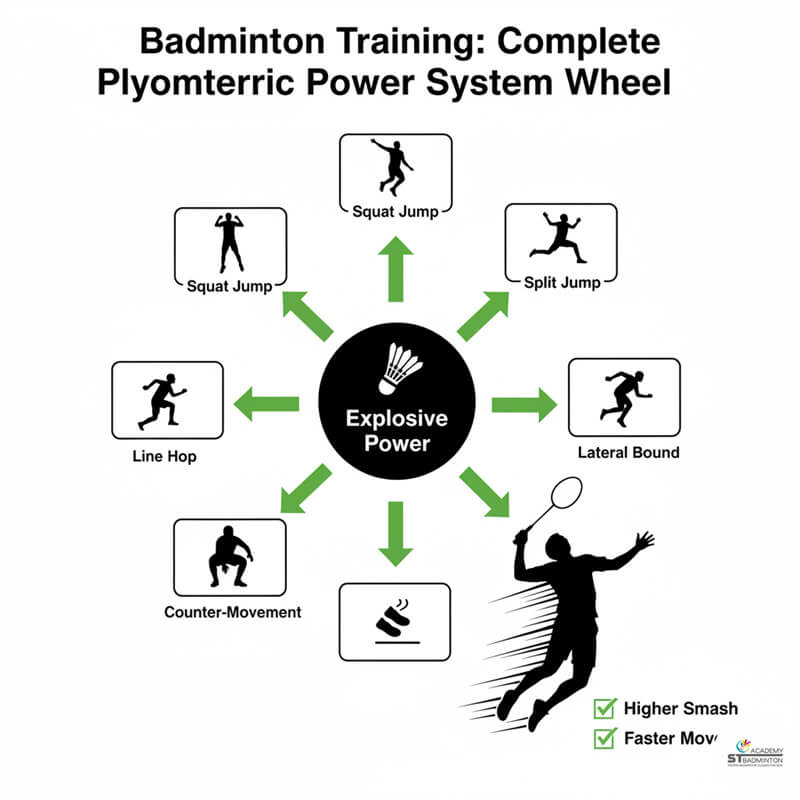

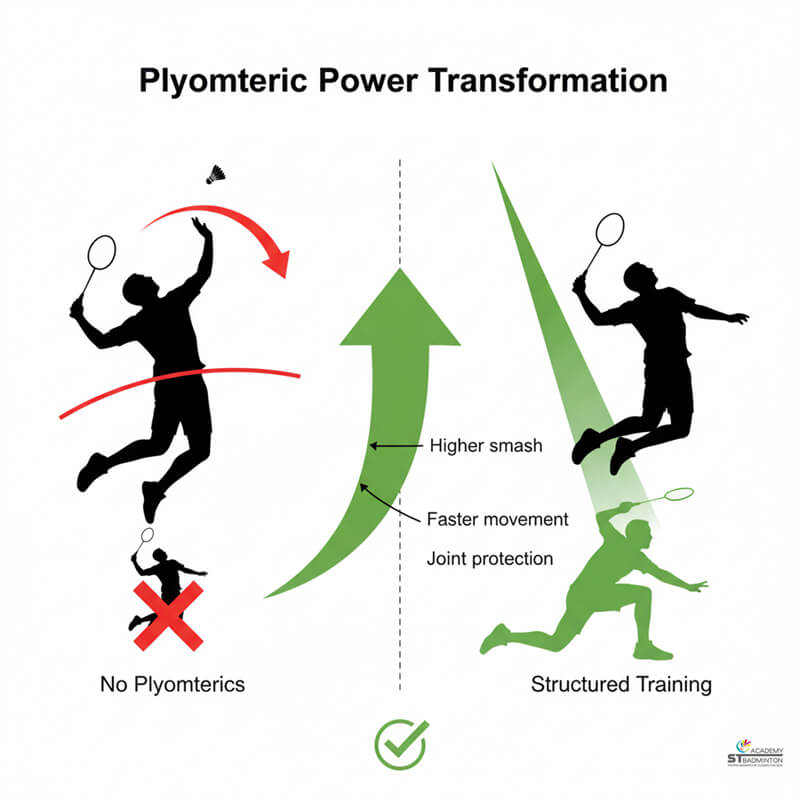
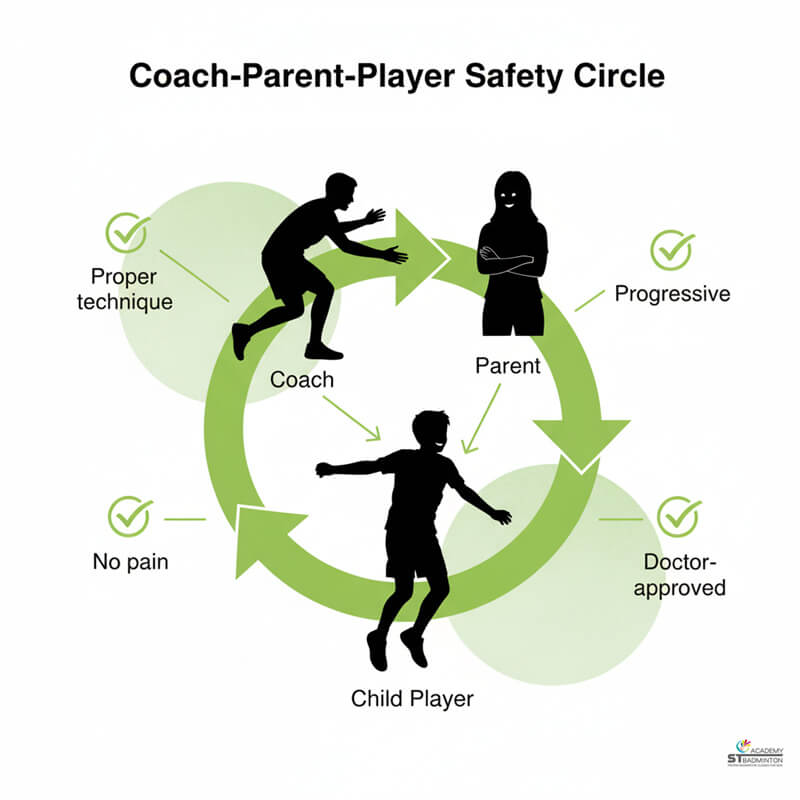
Benefits of Structured Plyometric Training
Incorporating safe progressive plyometric exercises into badminton training helps players in Malaysia and Singapore develop explosive power for higher jumps, faster direction changes and stronger court coverage. Our certified coach uses controlled progressions that build lower limb strength while protecting joints through proper landing technique and appropriate volume.
| Training Aspect | Random Jump Training | Structured Plyometric Program SAFE |
|---|---|---|
| Landing Technique | No focus on landing quality. Knees collapse inward and joints absorb excessive impact without control. | Teach soft controlled landing with bent knees tracking over toes. Build eccentric strength to protect joints safely. |
| Exercise Progression | Start with maximum height box jumps immediately. No foundation building before advanced movements. | Begin with basic squat jumps then progress gradually to split jumps and lateral bounds only when ready. |
| Training Volume | Jump until exhausted without counting repetitions. High injury risk from excessive fatigue and poor form. | Controlled sets and repetitions with full recovery between. Stop before technique deteriorates under fatigue. |
| Scheduling Logic | Add jumps randomly whenever without considering recovery. Train plyometrics when already tired from matches. | Schedule one to two sessions weekly with forty-eight hours between. Perform when fresh after warm-up not when fatigued. |
| Injury Prevention | No attention to warning signs like knee pain. Push through discomfort until serious injury develops. | Stop immediately if joint pain appears. Combine plyometrics with balance and strength work to reduce injury risk. |
| Badminton Integration | Copy random YouTube drills without badminton relevance. No connection to actual court movement patterns. | Select exercises that match badminton demands. Train vertical power, lateral bounds and direction change specifically. |
| Match Performance | Knee pain limits movement quality. Risk of chronic issues from poor landing habits developed through random training. | Higher jump smash and faster court coverage. Improved explosive power without joint damage from proper technique. |
Plyometric Badminton Training in Kuala Lumpur and Singapore
This guide helps players in Malaysia and Singapore understand how to safely incorporate plyometric exercises into badminton training to improve jump height, acceleration and explosive power. ST Badminton Academy provides structured plyometric training for serious juniors, school team players and adults in Setapak, Wangsa Maju, Selayang, Kepong, Cheras and surrounding areas. If you want coaching that builds explosive power through safe progressive jump training rather than random high-impact exercises that risk joint injury, contact us to learn about plyometric methods that improve your badminton performance across Malaysia and Singapore. Remember: Anyone with knee, ankle or back pain or other medical conditions should consult a doctor or physiotherapist before starting plyometric training.



